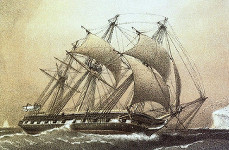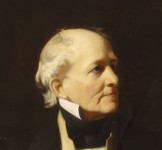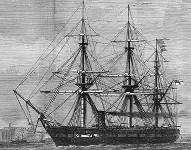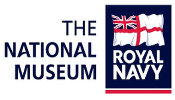|
| HMS Challenger, steam corvette (Photo Ships, click to enlarge) |
|
VOLUME
7
Contents in Full A
Modern Introduction
Introduction, 1857-1900 Ch 46. Civil History of the Royal Navy Ch 47. Military History of the Royal Navy (in preparation) Ch 48. Voyages and Discoveries (here) App
A to Ch 46-48: List of Flag-Officers Promoted
App B to Ch 46-48: List of H.M. Ships Lost, Etc., (in preparation) |
|
Note:
The images, all believed in the public domain, are
from a number of identified sites, for which my thanks
|
CHAPTER
48
VOYAGES AND DISCOVERIES, 1857-1900.
The Search for Franklin -
McClintock's success - The Hydrographers - The voyage of the
Challenger - Nares and Markham to the Arctic - The modern
surveying service.
The
Search for Franklin
Note: Franklin sailed in steam-engine-equipped bomb vessels HMS Erebus and Terror in 1845 to continue the search for the North West Passage across the top of Canada. Last sighted by Europeans that same year, the first search expedition was sent out in 1848. The wreck of the Erebus was found in 2014.
Note: Franklin sailed in steam-engine-equipped bomb vessels HMS Erebus and Terror in 1845 to continue the search for the North West Passage across the top of Canada. Last sighted by Europeans that same year, the first search expedition was sent out in 1848. The wreck of the Erebus was found in 2014.
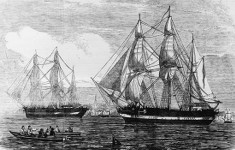 |
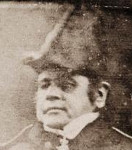 |
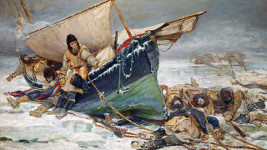 |
||
| HMS Erebus and Terror (Illustrated London News) | Captain Sir John Franklin ((c) National Maritime Museum | "The End in Sight", Franklin and crew painted by W Turner Smith 1847 (Granger Collection) |
SOON after the peace with Russia the news came that Dr. Rae, servant of the Hudson's Bay Company, had bought some silver spoons and forks, and a few other articles which had belonged to officers of Sir John Franklin's expedition, from a party of Eskimos. Their story was that the last survivors had died on a cape and an island near the estuary of the Back River. This was the very spot which the authorities had declined to search during the previous ten years, in spite of Dr. King's representations and entreaties. Their duty was now clear. An expedition must be sent to examine the shores of King William Island and ascertain the fate of Sir John Franklin and his gallant followers.
What the Admiralty did do was very different. They hurriedly paid the reward of £10,000, offered to anyone who discovered the fate of Franklin, to Dr. Rae in order to close the subject. They refused to send an expedition. In other words, the Government declined to lift a finger to discover the fate of those officers and men who, owing to Admiralty blunders, had perished in the service of their country. This refusal was in spite of the entreaties of Lady Franklin, and of all the leading scientific men in the country.
1857-59. DISCOVERY OF FRANKLIN'S
FATE. 563
Then Lady Franklin nobly came forward to spend her last shilling rather than that this disgrace should be incurred. The steamer Fox was purchased, and a small private expedition was equipped, almost entirely at her own expense. There could be no question as to the best man to command it. Captain Francis Leopold McClintock accepted the honourable post. Lieutenant William Robert Hobson went with him, and Allen Young, 1 an officer of the mercantile marine, gave not only his services, but also a large subscription towards the expenses of the expedition.
McClintock's
success
McClintock sailed in the spring of 1857. He was unfortunate in crossing Melville Bay. He was beset in the ice of the middle pack, and drifted southward down Baffin's Bay and Davis Strait throughout the winter. At length, during a gale of wind, the ice broke up, and, amidst fearful dangers from the heaving masses, the Fox was released from her long imprisonment. Most men would have sought a friendly port for rest and refreshment. Not so McClintock. He at once turned her head northwards.
In the season of 1858 he was more fortunate. He succeeded in reaching a bay down Prince Regent's Inlet, which was sufficiently near to his work, and which he made his winter quarters for 1858-59. The sledge-travelling commenced in the spring of 1859. He was to examine the whole coast of King William Island, and to visit Montreal Island at the mouth of the Great Fish River. Hobson was to search the north coast of King William Island, and Allen Young was to complete the discovery of Prince of Wales Island, by uniting the furthest points of Brown and Sherard Osborn.
McClintock went down the east side of King William Island and reached Montreal Island, finding various traces. After rounding Cape Herschel he came upon a most pathetic object. It was the skeleton of a young steward who had fallen down to die as he struggled onwards. Then he came to the boat, containing two skeletons and many articles belonging to officers of Franklin's expedition. The most important vestiges had already been discovered by Hobson.
For a second time McClintock trod this classic, almost sacred ground round Cape Victory before returning to his ship. The great discovery was the document signed by Crozier and FitzJames, which finally revealed the fate of Franklin and his devoted followers.
1
Born 1830; Lieut. R.N.R. 1862; comd. Pandora in Arctic Exped.
1875-7G; Kt. 1877; C.B.; retd. com. R.N.R. 1886.
564 VOYAGES AND DISCOVERIES,
1857-1900.
McClintock brought back the Fox to England in the autumn of 1859, amidst the plaudits of his countrymen. The Admiralty then recognised his services, and the Queen conferred upon him the honour of knighthood. Thus closed this famous episode in the history of our Navy. The despatch of Sir John Franklin's expedition and the work of the expeditions to ascertain his fate covered a period of fourteen years. It was a period when many officers and men were receiving a training and gaining experiences which were afterwards of great advantage to the service.
The Navy lost two of the hest friends it ever had when Sir John Barrow retired in 1845, and Sir Francis Beaufort in 1855. Neither long survived his retirement. The former died in 1849, the latter in 1857. It is said that good men's places are easily filled. Both these eminent men are still missed.
Captain John Washington 1 succeeded Sir Francis Beaufort as Hydrographer In 1836, he had made a journey to Morocco, and he had written a valuable account of it; he had been for several years Secretary of the Royal Geographical Society; and his surveying services had been chiefly on the English coast, in command of the Shearwater and Blazer. Washington died at his post in 1864.
In his time Captain Henry Mangles Denham, in the Herald, was carrying on surveys in the Fiji Islands and other parts of the Pacific from 1852 to 1859; while Arthur Lukis Mansell, 2 the worthy successor of Graves and Spratt, executed the Syrian survey in the Tartarus and Firefly, and in 1864 continued his excellent work in the Ionian Islands and on the coast of Albania.
Two other valuable surveying officers, Captains William Louis Sheringham, and George Augustus Bedford, were much employed on the coasts of England and Scotland; but Bedford was also on the west coast of Africa, and in the Gulf of St. Lawrence. In 1862 he succeeded Mr. Michael Walker as Assistant Hydrographer, and was afterwards Superintendent of Charts at the Admiralty.
Captain George Henry Richards, 3 who became Hydrographer in 1864, had served in the Sulphur and Samarang with Belcher, in the Philomel with Sulivan, and in the Acheron with Stokes. He was Commander of the Assistance in the Arctic regions from 1852 to 1854, and afterwards conducted a survey of the coasts of Vancouver's Island in the Plumper. It is to the credit of Sir George Henry Richards that, at least on one occasion, he followed success fully in the footsteps of Sir Francis Beaufort.
1
Entd. Navy 1812; Lieut. Jan. 1, 1821: Com. Aug. 14, 1833;
Capt. Mar. 16, 1842.
2 Com. Sept. 29th, 1855; Capt. Jan. 1st, 1805; retd. Mar. 7th, 1866.
3 See List of Flag-Officers.
2 Com. Sept. 29th, 1855; Capt. Jan. 1st, 1805; retd. Mar. 7th, 1866.
3 See List of Flag-Officers.
1872-75. THE "CHALLENGER"
EXPEDITION. 565
The voyage of the Challenger
It was mainly due to him that the Challenger was commissioned in 1872, properly equipped, and despatched on a scientific expedition round the world. The command was given to Captain George Strong Nares, 1 who had served with McClintock and Mecham in the Arctic regions, and since done good service as a surveyor. With him was associated a civilian scientific staff under Charles Wyville Thomson, 2 with which the naval officers always worked in perfect harmony. In 1875 Nares was recalled to command an Arctic expedition, and was succeeded by Captain Frank Tourle Thomson.
The Challenger expedition has justly acquired a world-wide reputation for the immense extent and value of its researches, more especially those connected with deep sounding and dredging, and the scientific examination of the great ocean beds. It has occupied many years to work up the numerous collections; and the twenty volumes of the results of the Challenger expedition, brought out under the auspices of Sir John Murray, 3 are the monument to one more peace-victory gained by the British Navy for the good of the whole civilised world.
During Sir George Henry Richards's term of office the revision of the survey of Magellan's Strait was undertaken by Captain Richard Charles Mayne, in the Nassau. For three years, 1866-69, that officer, who had served with Richards in the Plumper, conducted surveys from Punta Arenas to Cape Virgins, and from Cape Pilar to Port Famine. He also examined 255 miles of the channels from the Gulf of Penas to Magellan's Strait. Mayne was the author of 'Practical Notes on Marine Surveying.'
Nares
and Markham to the Arctic
The renewal of Arctic exploration became an important question, both for geography and for the Navy, as soon as the Fox returned. The loss of Sir John Barrow was then deeply felt. The long hard fight had to be fought without the aid of Sir Francis Beaufort. But Sherard Osborn was a host in himself. During his Arctic service, and long before, Sherard Osborn had been deeply impressed with the importance, indeed the necessity, of expeditions of discovery and research for the welfare of the Navy in time of peace. "Do not keep us for ever crossing topgallant yards and cleaning brass work!" he exclaimed. How much greater is the need now, when there are no longer topgallant yards to cross!
1
Born 1831; Capt. 1869; K.C.B. 1879; retd. Capt. Apr. 24, 1886;
retd. r.-adm. 1887; retd. v.-adm. 1892.
2 Born 1830; served with dredging expeds. of Lightning and Porcupine, 1868-69; prof, of nat. hist, at Edinburgh, 1870-81; Kt.; died 1882.: '
3 Born 1841; biologist; K.C.B. 1898.
2 Born 1830; served with dredging expeds. of Lightning and Porcupine, 1868-69; prof, of nat. hist, at Edinburgh, 1870-81; Kt.; died 1882.: '
3 Born 1841; biologist; K.C.B. 1898.
566 VOYAGES AND DISCOVERIES,
1857-1900.
Osborn read a paper hefore the Royal Geographical Society in 1864, advocating the renewal of polar research, which created a deep impression throughout the country. He was a man who was not to be beaten. He read another paper in 1867, and continued his advocacy in every shape and form, undaunted by fruitless interviews with First Lords, or by any other form of obstruction. At length his perseverance was rewarded. In the autumn of 1874 Mr. D'Israeli announced the intention of the Government to despatch an Arctic expedition, "to encourage that spirit of enterprise which had ever distinguished the English people."
An old sloop, the Alert, was selected, and a whaler, purchased for the service and strengthened for ice navigation, was re-named Discovery. The command was entrusted to Captain Nares, of the Challenger, with Albert Hastings Markham as Commander; and Captain Henry Frederick Stephenson commanded the Discovery.
Officers of great promise were appointed to the two vessels, such as Beaumont, 1 Aldrich, 2 Parr, 3 May, 4 Wyatt Rawson, 5 and Egerton. 6 The route selected was Smith Sound, at the head of Baffin's Bay. The Royal Geographical Society, through which body Sherard Osborn had conducted his propaganda, had always advocated the exploration of the polar region for scientific purposes, and not a foolish rush to the pole. But the instructions drawn up by the Admiralty contained the fatal order to go as far north as possible.
The expedition sailed in May 1875, and proceeded up Smith Sound, the difficulties of the navigation being overcome by Nares's consummate seamanship. The Discovery was left to winter in Lady Franklin Bay, and the Alert pressed northward to encounter the impenetrable polar pack, seen at other points by Parry, McClintock, Mecham, McClure, and Collinson. Nares was forced to winter on an open coast and at the edge of this pack, the most northern winter quarters ever formed.
1
Lewis Anthony Beaumont, 1st Lieut, of Discovery; see list of
Flag-Officers.
2 Pelham Aldrich, 1st Lieut, of Alert; see list of Flag-Officers.
3 Alfred Arthur Chase Parr, 2nd Lieut, of Alert; R.-Adm. May 24, 1901.
4 William Henry May, 4th Lieut, of Alert; R.-Adm. Mar. 28, 1901.
5 Wyatt Rawson, 3rd Lieut, of Discovery; mort. wounded at Tel-el-Kebir; promd. Com.; died Sept 21, 1882.
6 George Le Clerc Egerton, Sub-Lieut, of Alert; Capt. Jan. 1, 1893.
2 Pelham Aldrich, 1st Lieut, of Alert; see list of Flag-Officers.
3 Alfred Arthur Chase Parr, 2nd Lieut, of Alert; R.-Adm. May 24, 1901.
4 William Henry May, 4th Lieut, of Alert; R.-Adm. Mar. 28, 1901.
5 Wyatt Rawson, 3rd Lieut, of Discovery; mort. wounded at Tel-el-Kebir; promd. Com.; died Sept 21, 1882.
6 George Le Clerc Egerton, Sub-Lieut, of Alert; Capt. Jan. 1, 1893.
1875-76. ARCTIC EXPLORATION. 567
Some very gallant work was done during the autumn travelling, and the two young officers, Rawson and Egerton, distinguished themselves in the very early spring by opening communications between the two ships. But the seeds of scurvy had been sown during the long winter, and broke out soon after the spring travelling commenced. The fatal Admiralty order to press northwards under all circumstances also hampered the operations. But all was done that brave men could do.
Markham and Parr pushed northwards over the polar pack, dragging heavy boats which obliged them to make three journeys over the same ground, where the ice was broken up into endless ridges of hummocks. Never had so hard a service been performed. The party reached the highest northern point up to that time attained by man. Aldrich explored the coastline to the east, Beaumont to the west, and the naturalists were indefatigable in their several departments. But the disease that had broken out so unexpectedly was a great hindrance to the work. The expedition, however, returned in the autumn of 1876, with the loss of only two men, and with an exceptionally rich harvest of scientific results.
Sir George Henry Richards had retired from the post in 1874, and was succeeded as Hydrographer by Frederick John O. Evans, C.B., 1 who had held the post of Superintendent of the Compass Department during the previous ten years. He held office until 1884, when he was succeeded by Captain William James Lloyd Wharton, 2 well known for his excellent work on the east coast of Africa.
On the return of the Alert she was sent to Magellan's Strait to complete the work of King, FitzRoy, and Mayne, again under the command of Sir George Nares, who was relieved by Captain John Fiot Lee Pearse Maclear to finish the commission.
The
modern surveying service.
The ordinary surveying service has since kept seven or eight small vessels employed, two for the British Isles, two for the Mediterranean, three for Australia and the Pacific, one in China, and one in the West Indies. But much valuable scientific work, including deep sea soundings, is done by the surveying vessels, in addition to surveys of coasts and harbours. There are two Captains, four Commanders, and about thirty Lieutenants and Sub-Lieutenants employed on board the surveying vessels.
The results of the British naval surveys during the nineteenth century have been that the whole world is supplied with admirably engraved charts, constantly corrected and brought up to date, and supplied with sailing directions.
1
Master, R.N. Nov. 23, 1841; retd. as captain June 5, 1872;
subsequently K.C.B.
2 Born Mar. 2, 1843; retd. as r.-adm. Jan. 1, 1895, but remained Hydrog.; K.C.B. 1897
2 Born Mar. 2, 1843; retd. as r.-adm. Jan. 1, 1895, but remained Hydrog.; K.C.B. 1897
568 VOYAGES AND DISCOVERIES,
1857-1900.
A contemplation of the work of naval expeditions since the time of Byron cannot fail to force the conviction that this is legitimate work for the Navy in time of peace. At the end of the century there appeared to be a tendency to abandon this glorious position; to seek no more for peace victories for our Navy; to give place to other nations in the work of discovery. But it only needs a more thorough study of the history of the Navy, and a more clear appreciation of her needs, in order that a public opinion may be formed which will restore us to the position we held at the time when Barrow and Beaufort could make their influence felt.
For success in war it is not only ships that we need, but also trained officers and men, who have acquired confidence and experience in the course of special service, in addition to a knowledge of the ordinary routine of mastless steamships.
|
VOLUME
7
Contents in Full A
Modern Introduction
Introduction, 1857-1900 Ch 46. Civil History of the Royal Navy Ch 47. Military History of the Royal Navy (in preparation) Ch 48. Voyages and Discoveries (here) App
A to Ch 46-48: List of Flag-Officers Promoted
App B to Ch 46-48: List of H.M. Ships Lost, Etc., (in preparation) |
or return to "Pax Britannica", 1815-1914
revised 13/10/15
